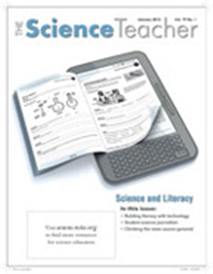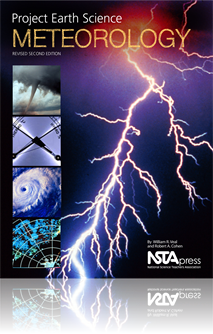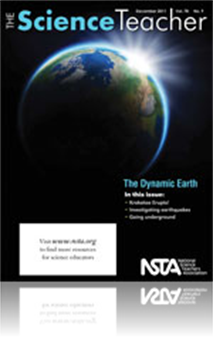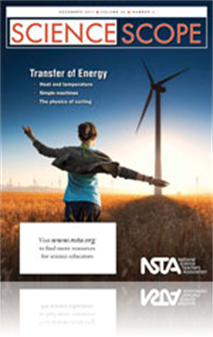All Resources
Journal Article
Teaching Through Trade Books: Gravity and Weight
This column includes activities inspired by children’s literature. This month’s issue explores the concept of gravity through several activities and readings....
Journal Article
This article presents the qualitative analysis of data from a 20-year project analyzing the knowledge and attitudes toward science of undergraduate students enrolled in introductory astronomy courses....
Journal Article
Science 101: What Causes the Tides?
This column provides background science information for elementary teachers. In this month’s issue the author discusses the reason tides occur....
Journal Article
Editor's Roundtable: Overlapping Reading and Writing Skills
Science Scope’s editor shares thoughts regarding the current issue....
Journal Article
This article describes NASA and NSTA teaching resources that can accentuate your Earth and space science lessons....
Journal Article
This column focuses on issues related to environmentally friendly and sustainable science. This month’s issue focuses on the pros and cons of nuclear energy....
Journal Article
Point of View: Who Is Catching Up With Whom? Internationalization of Science Education
This column shares reflections or thoughtful opinions on issues of broad interest to the community. This month’s issue compares Chinese chemistry and chemistry education to that of the United States....
Journal Article
Core Ideas of Engineering and Technology
This article addresses Chapter 8 of A Framework for K–12 Science Education, which presents core ideas in technology and engineering at the same level as core ideas in the traditional science fields....
Journal Article
Two Paper Airplane Design Challenges: Customizing for Different Learning Objectives
This article describes two examples of how a common, underlying design task—designing a paper airplane—was modified to meet the needs of two very different college science courses. These cases illustrate both important considerations in the desig...
Journal Article
Calibrated Peer Review Essays Increase Student Confidence in Assessing Their Own Writing
The online writing software Calibrated Peer Review (CPR) is a useful tool for writing assignments in large college classes. Students submit essays online and are guided in how to rate essays using criteria written by the instructor. The author of thi...
Journal Article
The "Science Literacy Through Science Journalism" project explores how the practices of good science journalism can inform high school science education. Students learn lifelong science literacy skills by reporting the news....
Journal Article
The New Teacher's Toolbox: The Dreaded (Sometimes Delightful) Parent Phone Call
This column shares tips for teachers just beginning their career. This month’s issue discusses tips for how to deal with talking to parents on the phone....
Journal Article
In this article the authors present the results of a study about the effects of incorporating literacy strategies with laboratory sections in a general biology course....
Journal Article
The Science Text for All: Using Textmasters to Help All Students Access Written Science Content
This article describes how one teacher uses the Textmasters strategy to motivate students to engage with the science textbook....
Journal Article
Nature Journaling: Enhancing Students' Connections to the Environment Through Writing
This article describes how the author shared her passion for nature with her sixth-grade students through nature journaling and how her students gained a better understanding of the natural world....
Journal Article
This article details how collaboration among the authors—science teacher educators and scientists—was forged and the benefits that have emerged, such as documentation of reformed teaching and significant gains in pre- and poststudent reports of e...
Journal Article
Editor's Note: Teacher Growth, Coupled With Early Introduction
Science and Children’s editor shares thoughts regarding the current issue. ...
Journal Article
Sinking Your Teeth Into Tooth Decay
This article integrates the important health concept of tooth decay with data analysis. Students learn about how different liquids affect tooth decay....
Book Chapter
Even though we cannot see it, water vapor is almost always present in the air, regardless of the temperature. This means that water vapor can exist at any temperature. What about liquid water? Can water exist as a liquid at any temperature? You will ...
Journal Article
Teaching Through Trade Books: Simple Machines
This column includes activities inspired by children’s literature. Engaging students with common machines such as playground equipment and tools will show them how machines make work and play easier as they gain an understanding of other physical s...
Journal Article
Students interact with a scientist virtually and make nanoscale observations of insects using an online scanning electron microscope....
Journal Article
The author presents the science and engineering practices from the recently released A Framework for K–12 Science Education: Practices, Crosscutting Concepts, and Core Ideas....
Journal Article
Technology and visual representations offer many ways to engage students in active inquiry. In this article students use planetarium software to gather data about the Moon....
Journal Article
The Early Years: Harness Your Tech Side
This column discusses resources and science topics related to students in grades preK to 2. This month’s issue discusses teachers using technology to help students develop a science inquiry....
Journal Article
A microscope connected to a digital projector helps students make connections between the microscopic and macroscopic world....
Journal Article
Use popular media to enhance instruction of simple machines and energy transfer. Popular culture can foster active thinking at key points in a lesson sequence, such as introductory pretest, formative review, homework practice, application, extension,...
Journal Article
This article uses a historic cataclysm to teach modern science. This study of Krakatoa offers an opportunity to correct common student misconceptions about volcanoes....
Journal Article
Scientific and Engineering Practices in K–12 Classrooms
The author presents the science and engineering practices from the recently released A Framework for K–12 Science Education: Practices, Crosscutting Concepts, and Core Ideas....
Journal Article
Middle school students can develop and enhance their observation skills by participating in teacher-guided scientific inquiry activities where they observe animals that tend to act in known, predictable ways. Using madagascar hissing cockroaches can ...
Journal Article
Science 2.0: Dynamic Lessons With Google Earth
This column shares web tools that support learning. This month’s issue discusses the "layers" feature of Google Earth....
Journal Article
In this activity students investigate and monitor fault zones around the world and learn about seismology....
Journal Article
Scope on the Skies: Getting to Mars
This column focuses on astronomy throughout the year. This month’s issue discusses missions to Mars....
Journal Article
Studying the Olympic sport of curling is a fun, engaging way to learn about the concepts of friction, forces, momentum, and Newton's laws. Students enjoy and benefit from hands-on, experiential learning activities, and sports show students how they c...
Journal Article
Investigating Continental Margins
In this article students investigate North America's continental margins using GeoMapApp, a free global topography database. Each student investigates continental margins along the East, West, and Gulf Coasts, determines the nature of these margins, ...
Journal Article
The Green Room: Global Environmental Issues
This column focuses on making your teaching more environmentally friendly. This month’s issue presents several global environmental issues and suggests a classroom activity for each....
Journal Article
The New Teacher's Toolbox: Teaching With Current Events
This column shares tips for teachers just beginning their career. In this month’s issue the author emphasizes that everyday science events can provide plentiful connections to classroom science content....
Journal Article
Idea Bank: An Environmentally Responsible Physics Course
The Idea Bank provides tips and techniques for creative teaching, in about 1,000 words. This month’s Idea Bank discusses emphasizing energy in an introductory physics course....












